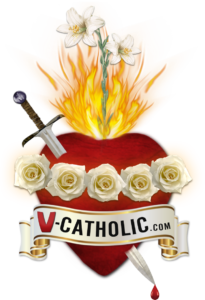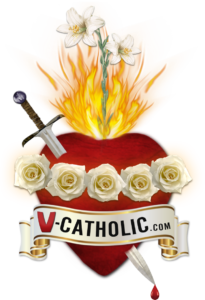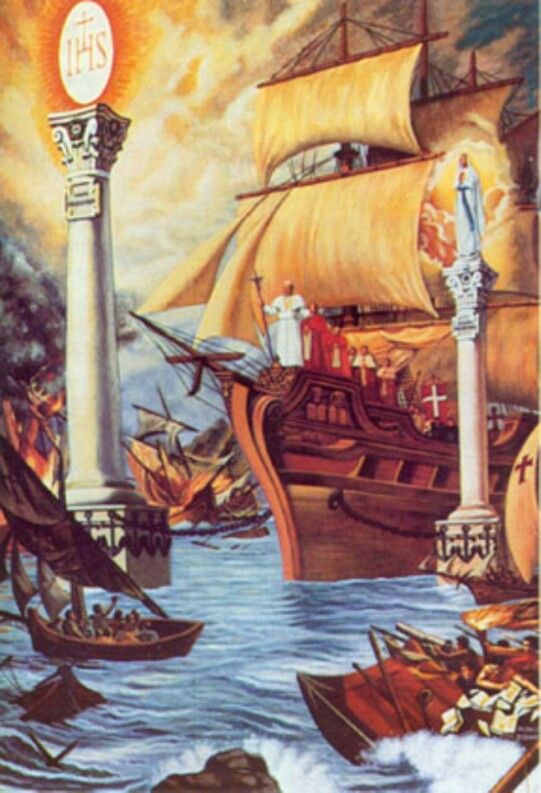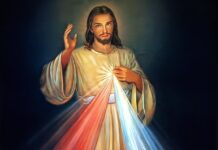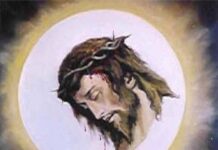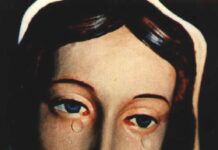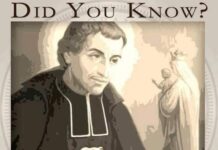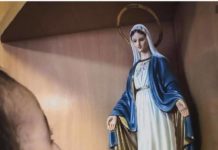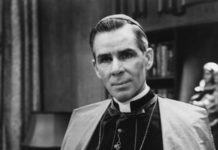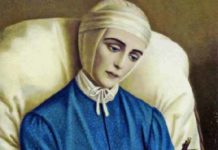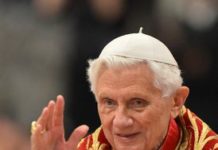From the book “Don Bosco’s Madonna”
IT WAS MAY 30, 1862, penultimate day of the Month of Our Lady. After night prayers, before hundreds of boys went to bed, Don Bosco started like this:
“I want to recount to you a dream. It is true that he who dreams does not reason. In spite of that, I, who would recount to you even my sins if I were not afraid of making all of you run away and making the house collapse, will narrate it to you for your spiritual benefit. I had this dream a few days ago.
“Just imagine you were with me on a sea beach, or rather, on an isolated cliff and you did not see any other landscape except that under your feet. On that vast surface of water there was an innumerable multitude of ships arrayed for battle. Their prows were equipped with a beak of sharp iron in the form of a knife or arrow which hurt and pierced through where it clove. These ships were armed with cannons, equipped with guns and arms of every kind, incendiary materials and even books. They advanced against another ship much bigger and taller than all of them, trying to ram it with their beaks, to set fire to it, or at least to cause any possible damage to it.
“Behind that majestic flag-ship, equipped on all sides, there was a convoy of many small ships and sailing vessels which took signals of command from her and carried out operations of self-defense from the enemy fleets. The wind was against them and the agitated sea seemed to favor the enemy.
“In the midst of the immense expanse of the sea there sprung up from the waves two very high pillars, one a little distant from the other. On top of one there was the statue of the Immaculate Virgin, at whose feet hung a large placard with this writing on it: Auxilium Christianorum (Help of Christians) over the other which was much bigger and higher, there was a Host proportionate in size to the pillar, and below it there was a placard with these words: Salus Credentium (Salvation of Believers).
“The Supreme Commander on the big ship, who was the Roman Pontiff, saw the fury of the enemies and the crucial situation in which his faithful were involved. He decided to convene around him the pilots of the minor ships for consultation and measures to be taken. All the pilots went up and assembled around the Pope.
“They held council, but since the wind became more furious, they were sent back to control their own ships.
“The situation having improved a little bit, the Pope assembled the pilots around him for the second time, while the flag ship continues its course . But the tempest became frightful again.
“The Pope remained at the helm and exerted all his efforts to steer the ship to the middle of the pillars from the top of which were hung all around many anchors and huge hooks attached to chains.
“All the enemy ships made a rush to attack her and went all out to capture and sink her. Some with writings, books, and incendiary materials with which they were fully armed were trying to slant her; others with their cannons, guns and beaks. The fighting became more and more fierce. With the prows, the enemy made violent thrusts, but their efforts and assaults proved ineffective. Their repeated attempts proved unavailing. All their exertions and munitions ended in sheer waste. The big flag ship proceeded safe and undeterred in her course. It happened that now and then she received formidable hits which made large and deep cracks in her sides. But no sooner had she inhaled a puff of air coming from the two pillars than the damages and the gaps were closed and the rifts plugged. In the meanwhile, the cannons of the attackers burst, the guns snapped, so also were other arms, and the books were destroyed. Many ships were attacking from close quarters with small arms: with the hands, with blasphemies and curses.
“Somehow or other, the Pope was hit seriously and fell down. Once those around him went to his rescue and lifted him. The Pope was hit the second time. He fell down again and expired. A shout of victory and jubilation arose from the enemies. There was rejoicing in their ships. But immediately after the death of the Pontiff, another Pope was installed in his place. The assembled pilots had elected him so quickly that the notice of the death of the Pope arrived with the notice of the election of his successor. The adversaries began to lose courage.
“By dislodging and overcoming every obstacle, the new Pope managed to steer the ship up to the two pillars and on arriving between them, he tied it with a chain which hung from the prow to an anchor of the pillar on top of which there was the Host; then with another chain he tied it from the side opposite to another anchor attached to the pillar on which was placed the Immaculate Virgin.
“Now followed a great upheaval. All the ships which up to that moment had fought against the flag ship on which the Pope sat, took to flight, and dispersed, knocked and clashed with one another. Some went down and tried to sink the others. Some small ships which had fought bravely together with the Pope came along with the former to tie themselves to those pillars.
“Many other ships which had retreated for fear of battle remained at a great distance, watching prudently, until the wreckage of all the shattered ships were swallowed up in the gorges of the sea. Then they moved very slowly in the direction of the two pillars. As soon as they arrived there, they attached themselves to the hanging hooks and remained there happy and safe, together with the flag ship on which the Pope was. A great calm reigned in the sea, a supreme calm it was.”
At this point Don Bosco asked Don Rua, “What do you think of this narrative?”
Don Rua replied: “It seems to me that the ship of the Pope is the Church, whose head he is; the other ships are men; the sea is this world. Those who defend the huge ship are good people who love the Holy See; the others are her enemies who, with all sorts of arms, make attempts to annihilate her. The two pillars of salvation seem to be devotion to Mary Immaculate and the Most Holy Sacrament of the Eucharist.”
Don Rua did not mention the Pope who fell dead, so Don Bosco was also silent on this point. He only added: “You have said well. Only one expression must be corrected: the enemies’ ships are the persecutions; they prepare very serious troubles for the Church. What has taken place so far is almost nothing compared with what will occur. Her enemies are the ships which make an attempt to sink the flag ship, if they can. There remain only two means to save ourselves in the midst of so much danger and confusion. Devotion to Mary Immaculate, frequent Confession and Communion. It is necessary to use every means and try our best to practice them and have them practiced everywhere and by all. Good night!”
Slowly and silently, the boys swarmed out to rest with the dream of the Two Pillars in their hearts: the filial love of Our Lady, who is the Mother of Adolescents and the sacramental life, which is the Eucharist. With these two great loves, their inclusion in the Church becomes joyful and beautiful even if they have to fight. So boys perhaps do not like adventure and struggle?
